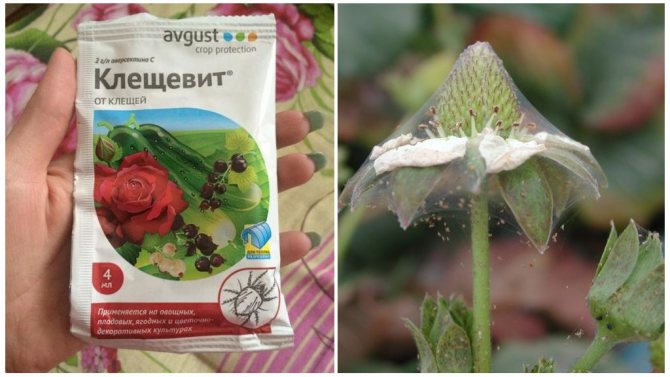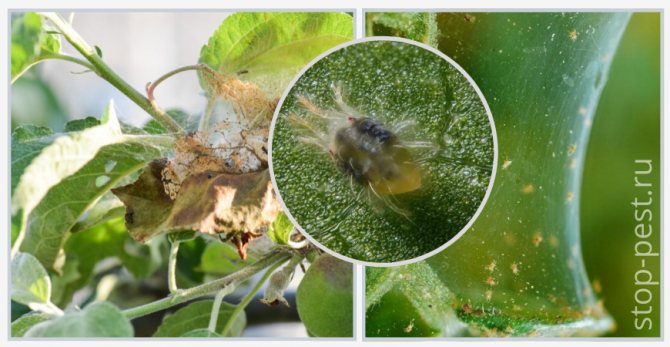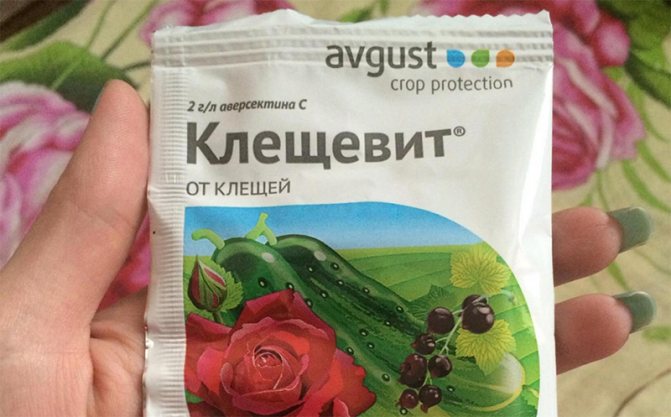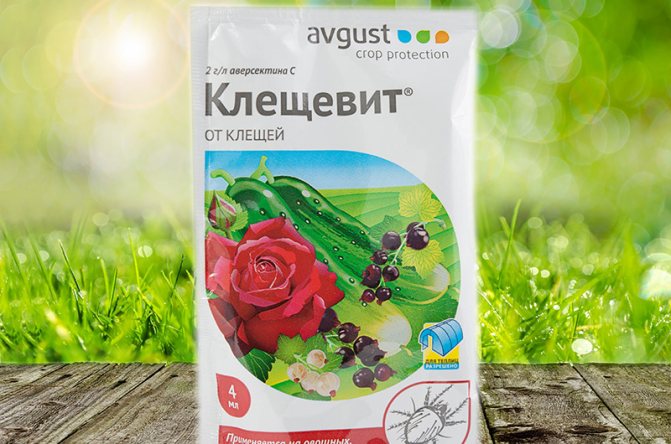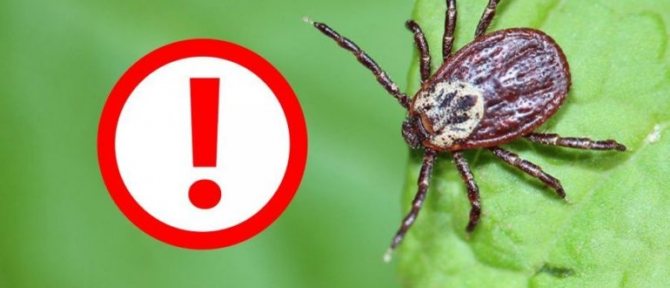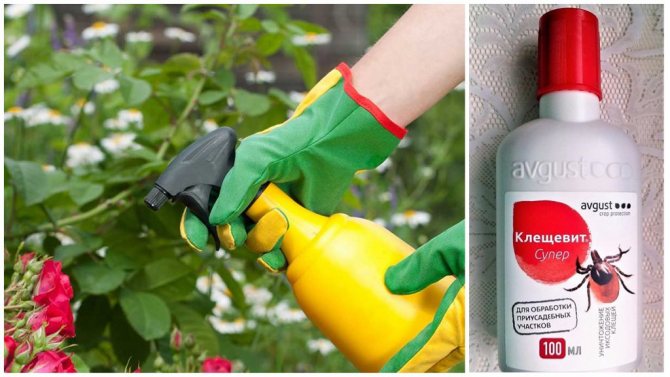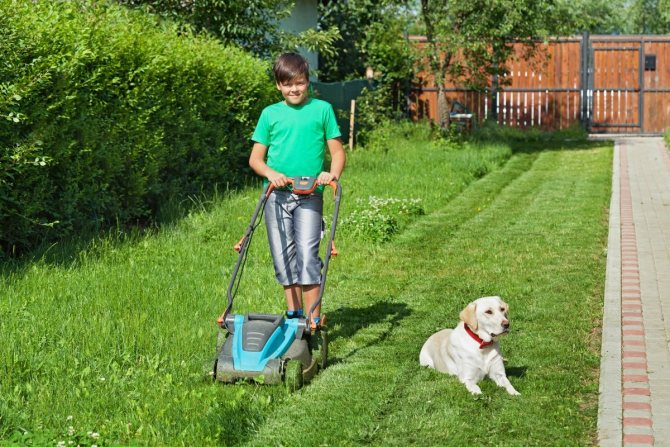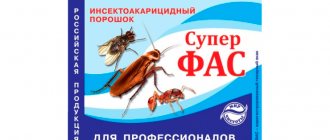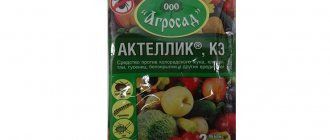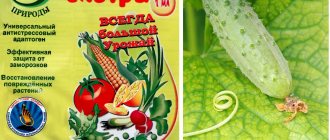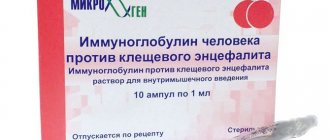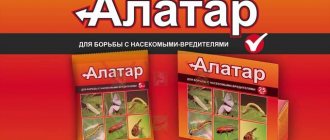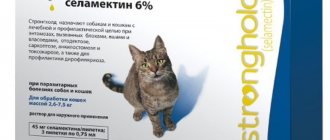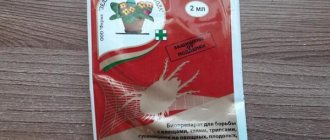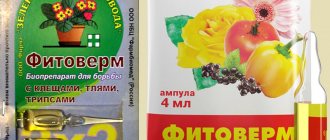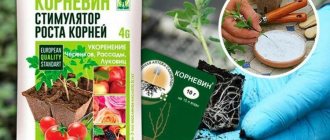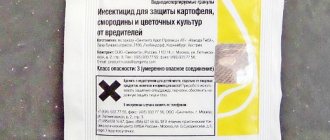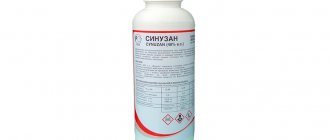The emergence of three insectoacaricides under the general name Kleschevit is definitely the fruit of what is called marketing policy. More precisely - her misunderstanding, tk. the composition, purpose and methods of using Kleshchevites are very, very different. These pesticides have in common only, RF) and the preparative form of the CE emulsion concentrate. For the rest (I almost wrote "the beautiful marquise"):
- Kleschevite “Simply” is an insectoacaricide for private household plots. DV aversectin C at a concentration of 0.2% (2 g / l). Designed for the systematic protection of plants, primarily from spider mites on fruit and berry open ground, fruit and vegetable and flower protected ground, as well as on deciduous and decorative and flower potted crops, incl. indoor. Packing - 4 ml ampoules and 10 ml vials;
- Kleschevit Super - means for the destruction of ixodid ticks in unproductive cultural areas (lawns, flower beds). DV technical cypermethrin (a mixture of isomers of variable composition) at a concentration of 25% (!), 250 g / l. Packing - bottle 100 ml;
- Tickchevit Super Spray - preventive sanitary and household acaricide against blood-sucking ticks and fleas. DV alpha-cypermethrin at a concentration of 0.25% (2.5 g / l). Purpose - processing clothes before going out to areas unfavorable for ixodid ticks, sandy and animal fleas. The release form is a ready-to-use aerosol can of 100 ml.
Note: There is no chemical, biological and technological difference between the destruction of ixodid ticks on your lawn and the clearing in the forest, chosen for picnics, across the road. But there is a legislative one. In the first case, honor and praise to you, you are a zealous owner. In the second, you have arbitrarily entered the sphere of responsibility of the competent authorities. Liability is not criminal, but disgusting and not cheap.
Composition and form of release
Kleschevit is produced by Russian. The product is a concentrated emulsion with a mild unpleasant odor.
Kleschevit contains the active ingredient aversectin. This component has an effect on the nervous system of pests, as a result of which, after 8 -10 hours, their physical activity and ability to feed are disrupted. Insects die 3-6 days after eating the treated leaves. The period of protective action of the drug is 5-7 days.
Kleschevit has three forms of release:
- Kleschevit - the active ingredient is aversectin C at a concentration of 0.2%, available in 4 ml ampoules or 10 ml vials.
- Kleschevit Super - based on technical cypermethrin at a concentration of 25%, sold in bottles of 100 ml.
- Kleschevit Super in the form of a spray - produced in the form of an aerosol, which is contained in 100 ml cans. The active component of the spray is alpha cypermethrin at a concentration of 0.25%.
Recommendations
- The emergence of resistance is unlikely, but it is recommended to alternate with insecticides and acaricides from other chemical groups.
- It should be borne in mind that the effect of the drug largely depends on the air temperature. With its decrease from 24 to 17 ° C, the toxicity for the common spider mite decreased by 7.6 times, and with an increase to 32 ° C it increased by 4.8 times.
- The drug "Kleschevit, KE" is a complete analogue of "Fitoverm, KE", only with the concentration of the active substance 2.5 times less, therefore, when choosing, it is better to give preference in favor of the latter.
Advantage and scope
The main benefits of an insecticide include:
- Fast exposure period.
- Safety for warm-blooded animals (the drug has low toxicity).
- High efficiency in the fight against various insect pests.
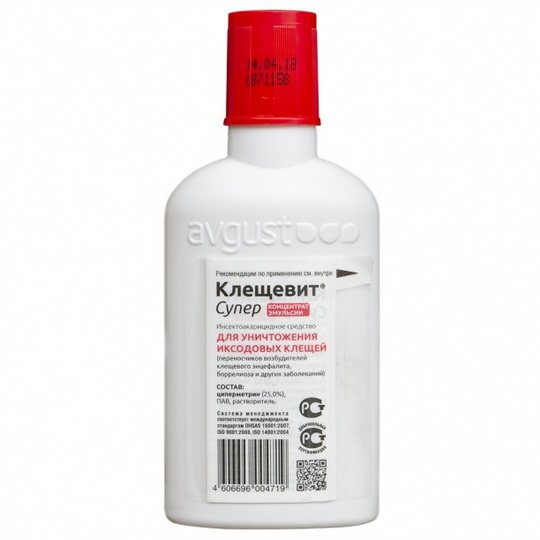
The scope of the product depends on its form of release.
- Kleshchevit 0.2% - used in the fight against spider mites on fruit and berry crops growing in the open field. The tool is also effective in the treatment of fruit, vegetable and flower crops, potted plants. This form can be used to treat greenhouse plants and indoor flowers.
- Kleschevit Super - used to combat ixodid ticks on flower beds and lawns.
- Spray Kleschevit Super - the purpose of this preventive sanitary and household acaricide is to process clothes before visiting places where ixodid ticks and fleas live.
Kleschevit reviews
In general, the mite works in the same way as fitoverm, many growers will call it a weak remedy, it helps someone a lot. Why are there such conflicting reviews? The fact is that the drug helps only if the pest feeds on sprayed leaves or when there is contact with insects or arthropods (ticks).
If there are pests on the plants in the stage of eggs or non-feeding larvae, there will be no effect. In addition, adult pests (imago stage), which, during spraying, hide in secluded places - leaf axils, inside a deformed leaf blade, will not suffer either - the solution will not touch them. If you moisten the leaves poorly, then they will not even get drunk on the poisonous part of the leaf. The problem of castorite is that the drug does not have a systemic effect - it does not penetrate deeper into the leaf. Those. if the sheet was moistened only from above, and the solution did not get on the reverse side, this part of the sheet remains defenseless.
You can expect good results from the castorite plant if you sprayed the whole plant in the most thorough way, small indoor flowers can be completely dipped in the solution. We can say that the drug is completely useless for spraying plants (varieties) with curly leaves, for example, ficus baroque, or if the leaves are severely deformed, for example, the skewed tops of branches of raspberries should be treated by dipping in a bucket with a solution, and not trying to spray.
Plus and the undoubted advantage of the drug Kleschevit in its low toxicity - it is destroyed on the leaves 2-3 days after processing, and in the fruits of vegetables after 2 days. This means it can be used to spray homemade fruit lemons, vegetables and berries in the garden 3 days before harvest.
Do not use the drug Kleschevit more than three times the resistance increases (each time the percentage of survivors is more and more).
It was found that the effectiveness of the insecticide against spider mites is greatly influenced by the air temperature, for example, the drug is most toxic at a temperature of 30-32 ° C, more or less effective in the range from 24 to 26 ° C, not effective at temperatures below 20 ° C. The explanation is simple - the tick development cycle at high temperatures is accelerated, most of the feeding individuals have time to get under the action of the drug.
Types of ticks and effects on them
Kleschevite is only able to exert a contact effect, therefore, the treatment of larvae and mites hidden in the buds and folded leaves is not effective.
The best effect is observed when fighting the following types of ticks:
- Ixodic - this species does not cause significant harm to plants, but can lead to infection with the most dangerous infections of borreliosis or encephalitis.
- Spiderweb - an arachnid insect that multiplies rapidly and eats plant cells. The activity of the pest leads to disruption of photosynthesis, a strong decrease in productivity. Spider mites are also carriers of gray mold spores and viral infections.
- Kidney - damages the buds of plants, which leads to a decrease in yield, leaf fall, soreness of young shoots.
- Mealybug - is a sucking parasite with a whitish bloom on the surface of the body. Mealybug larvae and females deplete the shoots, roots and buds of plants, sucking out nutrients from them. Massive damage to the plant by this type of pest and the lack of timely treatment leads to the death of crops.
Folk remedies for spider mites
Calm and only calm! If the number of spider-like monsters on your plant is small, then it is quite possible to get by with folk means of destruction.
1. Medical alcohol
A fairly effective remedy for spider mites is medical alcohol (96%). Moisten a cotton swab with it and wipe the leaves of the plant - the mite will be destroyed (recall that you cannot take eggs this way!). Alcohol has the ability to evaporate quickly, so the leaves of the plant should theoretically not be damaged. However, it is still better not to experiment in this way with thin fuchsia or petunia leaves. But ficus, hibiscus, date palm, dieffenbachia and other "thick-skinned" will not even feel the touch of alcohol.
2. Soap (laundry soap is better, but any other will do as well)
If you have a spider mite, you can treat the plant with regular soap. To do this, we bring our plant into the bathroom and wipe all the leaves and branches with a soapy sponge. The more foam the better. We soap the pot and the pallet just as well. We also spray the ground with soapy water, but just a little, so as not to get on the roots and damage the plant. Unfortunately, some growers act radically and shed the entire earthy clod, and then they are surprised that the plant has dried up in a week. Do not repeat other people's mistakes, there should be a measure in everything!
So, after you soap the plant, do not rush to rinse off the foam. Wait 3-4 hours - this will be enough. The soap forms a film on the leaves through which gas exchange does not occur, that is, the plant “does not breathe”. Therefore, leaving it in such lathery conditions overnight is risky. After the soap is washed off, cover the plant with a bag for a day, without waiting for the water droplets to dry. This will be a "double blow" for those ticks that survived the soap. The increased humidity under the bag will become intolerable for them and they will die.
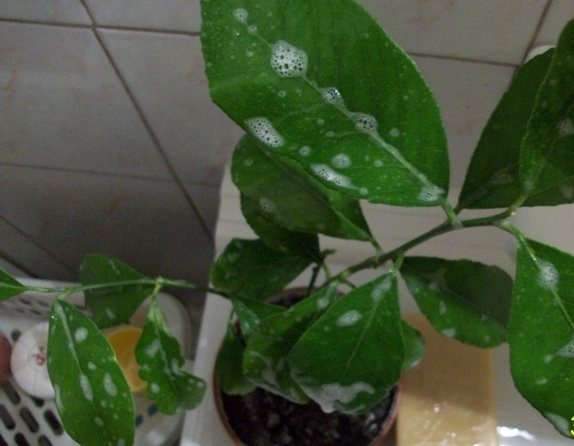

Soap is an effective remedy for spider mites
You can often find a recommendation to spray plants with soapy water instead of rubbing them with a sponge. In some cases, this is the only correct solution, for example, when many plants with small leaves are infected. Wipe each leaf - you will be tortured, but you can spray it in a matter of minutes.
By the way, as an alternative to soap, you can use any dishwashing detergent, for example, the same "Fairy".
3. Infusion of garlic
We take two heads of garlic and chop them finely. We put the resulting raw material in a jar and fill it with 1 liter of water, close with a lid. We put the jar in a dark cabinet and leave for 5 days. After this period, we spray the plant with the resulting infusion, diluted with water in a 1: 1 ratio.
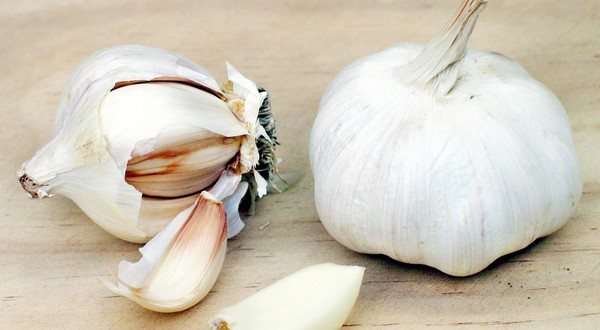

The tick drinks the "blood" of plants and therefore, like any vampire, is very afraid of garlic
4. Infusion of onion peel
Pour 100 g of onion husks with 5 liters of water and leave for 4-5 days. After the infusion, filter and spray the affected plants.
Consumption rates
Spraying plants with a solution of weak concentration will not give a positive result.The use of higher doses can lead to the formation of burns on the leaves. The lack of results is also caused by the introduction of an insufficient amount of the drug. Therefore, Kleschevit must be applied strictly according to the instructions, adhering to the dosages and method of application recommended by the manufacturer.
- The consumption rate of the drug when spraying cucumbers, tomatoes, peppers and eggplants is 1 liter of working fluid per 100 m².
- Consumption for 1 currant bush - 1 liter.
- For one tree, from 2 to 5 liters of working agent is required, depending on the age and size of the fruit crop.
- For the treatment of flowers growing in the open field, 1 liter of solution is used per 10 m² of plantings.
- The consumption rate of Kleschevit for indoor plants is 0.1 liters of working fluid per 1 m².
Compatibility of Kleschevit with other drugs
The manufacturer does not recommend combining Kleschevit acaricide with other drugs. However, according to gardeners, the drug is combined with pesticides such as Actellik, Fufanon, Talstar. The dosage in this case for each agent is recommended to be halved. It is also possible to alternate Kleschevit with biological insectoacaricides, for example: with bitoxibacillin.
Mixtures with growth regulators and fungicides of neutral or acidic reaction do not cause any complaints. It is permissible to add green soap to the working solution for indoor plants as an adhesive.
Compliance with safety measures
Tickshevite can harm bees, so it is recommended to isolate the hives before starting work. For humans, the drug does not pose a great danger, however, during spraying, the following precautions must be observed:
- Use a protective mask, gloves, gown.
- Avoid eating food, drinks. Also, do not smoke while spraying.
- Carry out processing in calm weather.
- At the end of the work, wash your hands thoroughly with detergent, wash, take a shower.
If the solution enters the nasopharynx, it is recommended to take activated charcoal and wash down the tablets with plenty of clean water.
Precautions
Kleschevite belongs to the 3rd hazard class. It is not harmful as long as it is used according to instructions and precautions.
- Kleschevite is suitable not only for the destruction of pests, but also for the prevention of their appearance.
- The drug is diluted in containers in which food is not consumed.
- When mixing the solution and using it, you must wear protective goggles, gloves and a respirator.
- The finished solution is used within 1 hour after mixing. But an unopened insectoacaricide can be stored for 2 years.
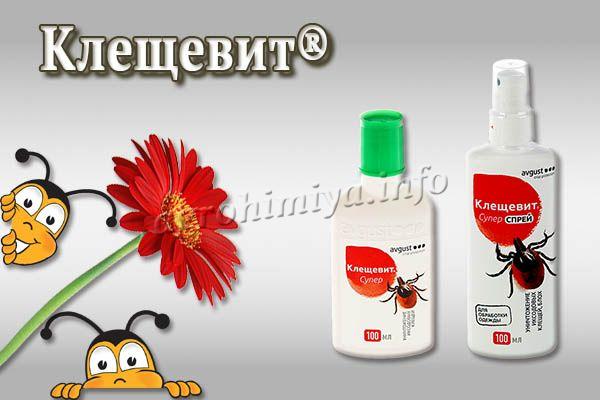

Tickshevite is dangerous for bees, therefore, it is not recommended to process plants during flowering.
- Tickshevite is dangerous for bees, therefore, it is not recommended to treat plants during flowering with this agent.
- After using the drug, wash your hands and face with soap and water. If the product gets on your hair, you must also wash it or just take a shower.
Important!
If, when mixing Kleschevite and another drug, no sediment occurs, then most likely the funds can be used in combination. And yet, before full processing, it is worth testing this mixture on one plant to check the reaction.
Some gardeners mix Kleschevit with other acaricides, insecticides, others believe that it is dangerous. So, if necessary, you can simply mix a small amount and test on a small area. If there is no harm, you can make a large amount of working fluid and use it to treat crops.
Storage conditions and shelf life
To store the insecticide, you must use a dry, cool place, protected from direct sunlight. The product is stored away from food, animal feed.Its shelf life is 2 years from the date of manufacture.
Since the solution does not affect pests hiding in folded leaves, it is recommended to remove and burn such leaves. The agent is not able to affect the eggs of the ticks - they do not eat the sap of the plants and, accordingly, cannot be poisoned. In order to achieve the complete destruction of pests, including young ticks emerging from eggs, it is necessary to carry out several treatments.
Summing up
As you can see, the spider mite is a rather serious problem, which requires the use of a whole range of actions. But if you pay attention to the condition of flowers in time and take measures, then you can quickly deal with these pests.
If you want to use the drug to combat any pests, you must strictly adhere to the recommendations specified in the instructions, namely dosages, proportions, processing methods. Improper use can harm houseplants.

